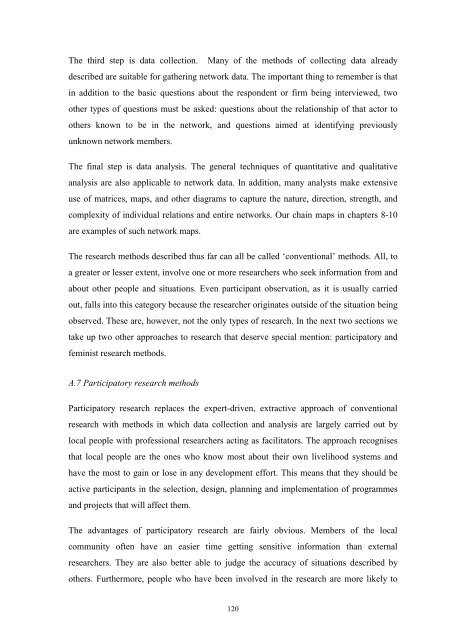McCormick+Schmitz Handbook for value chain research on - PACA
McCormick+Schmitz Handbook for value chain research on - PACA
McCormick+Schmitz Handbook for value chain research on - PACA
You also want an ePaper? Increase the reach of your titles
YUMPU automatically turns print PDFs into web optimized ePapers that Google loves.
The third step is data collecti<strong>on</strong>. Many of the methods of collecting data already<br />
described are suitable <str<strong>on</strong>g>for</str<strong>on</strong>g> gathering network data. The important thing to remember is that<br />
in additi<strong>on</strong> to the basic questi<strong>on</strong>s about the resp<strong>on</strong>dent or firm being interviewed, two<br />
other types of questi<strong>on</strong>s must be asked: questi<strong>on</strong>s about the relati<strong>on</strong>ship of that actor to<br />
others known to be in the network, and questi<strong>on</strong>s aimed at identifying previously<br />
unknown network members.<br />
The final step is data analysis. The general techniques of quantitative and qualitative<br />
analysis are also applicable to network data. In additi<strong>on</strong>, many analysts make extensive<br />
use of matrices, maps, and other diagrams to capture the nature, directi<strong>on</strong>, strength, and<br />
complexity of individual relati<strong>on</strong>s and entire networks. Our <str<strong>on</strong>g>chain</str<strong>on</strong>g> maps in chapters 8-10<br />
are examples of such network maps.<br />
The <str<strong>on</strong>g>research</str<strong>on</strong>g> methods described thus far can all be called ‘c<strong>on</strong>venti<strong>on</strong>al’ methods. All, to<br />
a greater or lesser extent, involve <strong>on</strong>e or more <str<strong>on</strong>g>research</str<strong>on</strong>g>ers who seek in<str<strong>on</strong>g>for</str<strong>on</strong>g>mati<strong>on</strong> from and<br />
about other people and situati<strong>on</strong>s. Even participant observati<strong>on</strong>, as it is usually carried<br />
out, falls into this category because the <str<strong>on</strong>g>research</str<strong>on</strong>g>er originates outside of the situati<strong>on</strong> being<br />
observed. These are, however, not the <strong>on</strong>ly types of <str<strong>on</strong>g>research</str<strong>on</strong>g>. In the next two secti<strong>on</strong>s we<br />
take up two other approaches to <str<strong>on</strong>g>research</str<strong>on</strong>g> that deserve special menti<strong>on</strong>: participatory and<br />
feminist <str<strong>on</strong>g>research</str<strong>on</strong>g> methods.<br />
A.7 Participatory <str<strong>on</strong>g>research</str<strong>on</strong>g> methods<br />
Participatory <str<strong>on</strong>g>research</str<strong>on</strong>g> replaces the expert-driven, extractive approach of c<strong>on</strong>venti<strong>on</strong>al<br />
<str<strong>on</strong>g>research</str<strong>on</strong>g> with methods in which data collecti<strong>on</strong> and analysis are largely carried out by<br />
local people with professi<strong>on</strong>al <str<strong>on</strong>g>research</str<strong>on</strong>g>ers acting as facilitators. The approach recognises<br />
that local people are the <strong>on</strong>es who know most about their own livelihood systems and<br />
have the most to gain or lose in any development ef<str<strong>on</strong>g>for</str<strong>on</strong>g>t. This means that they should be<br />
active participants in the selecti<strong>on</strong>, design, planning and implementati<strong>on</strong> of programmes<br />
and projects that will affect them.<br />
The advantages of participatory <str<strong>on</strong>g>research</str<strong>on</strong>g> are fairly obvious. Members of the local<br />
community often have an easier time getting sensitive in<str<strong>on</strong>g>for</str<strong>on</strong>g>mati<strong>on</strong> than external<br />
<str<strong>on</strong>g>research</str<strong>on</strong>g>ers. They are also better able to judge the accuracy of situati<strong>on</strong>s described by<br />
others. Furthermore, people who have been involved in the <str<strong>on</strong>g>research</str<strong>on</strong>g> are more likely to<br />
120














